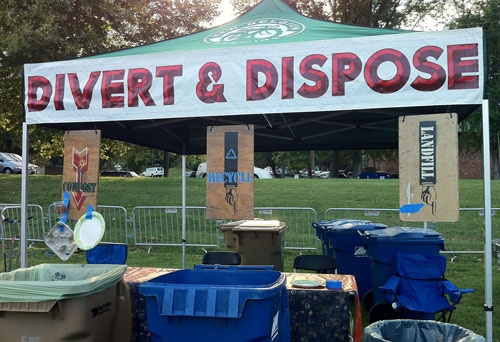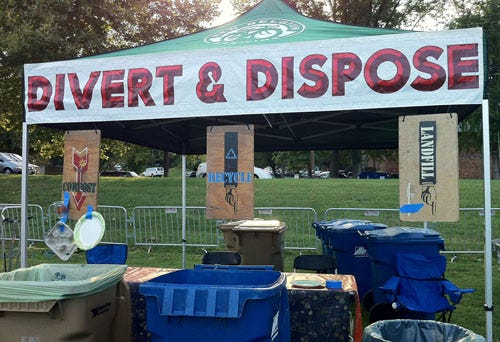January 30, 2014


New Belgium Divert and Dispose
The New Belgium Clips Beer & Film Festival made a stop in Charlottesville, VA, on Sept. 13. New Belgium recruited GreenBlue to organize compost, recycling and trash services for the event. With the help of Republic Services and Black Bear Composting (www.blackbearcomposting.com), staff diverted more than 90 percent of waste at the event-but not without effort.
New Belgium aims for zero-waste events. Food vendors are required to use compostable packaging, and New Belgium serves beer in compostable cups. New Belgium also forges partnerships with local organizations in each city to connect to waste outlets. It is a model they replicate at each new location.
Attendees chose one of two actions: leave their waste on the ground for staff to clean up later or visit one of the two "divert and dispose" stations housing bins. At these stations, GreenBlue helped hundreds of attendees select, or reselect, the correct bins. Each "divert and dispose" station had detailed signs to which we taped packaging examples.
GreenBlue staff are seasoned pros at waste diversion, yet, considerable time was spent confirming compostability or recyclability of foodservice items and helping attendees make the right choice. Even some of the seasoned pros in attendance selected the wrong bin.
We rely on consumers to make correct and informed choices everyday for us to retain the inherent value in packaging and close the loop. They are a crucial piece in the life cycle of packaging. However, as became fully evident at this event, we do not make it easy on them.
It is not always easy for consumers to figure out what materials make up a package, especially in dim festival lighting after a beer or two. The "which bin?" dilemma is compounded by recycling myths, new or unfamiliar materials, poor labeling, unclear instructions, lack of infrastructure and the desire to "just get rid of it."
While we spend a considerable amount of our lives on packaging, consumers do not. For the consumer to do the right thing, the packaging industry has to make it possible-and easy. For example, recycled content requires recycled materials, which requires consumers to recycle, which requires clear communication to consumers, which requires access to recycling, which requires recycling infrastructure, which requires recycling markets, and so on.
Many organizations and initiatives hope to solve at least a piece of this dilemma. SPC's own How2Recycle (www.how2recycle.info) label and other project work are among them. However, broad scale changes are necessary to achieve closed-loop systems and move society toward a sustainable materials economy. It is no short task, but a journey; one that GreenBlue and the Sustainable Packaging Coalition look forward to tackling with the industry. In the coming months, SPC will embark upon a new initiative to give new life to this process.
Connecting with "the consumer's dilemma" and seeing how difficult it was to work towards the zero waste goal at this small event was a great way for GreenBlue to experience these issues firsthand.
The real-world situation proved exciting, interesting and informative, and demonstrated that opportunities in packaging innovation that make closing the loop easier for consumers abound.
Author Danielle Peacock is project associate at GreenBlue's Sustainable Packaging Coalition. For more information about the SPC, visit www.sustainablepackaging.org.
.
About the Author(s)
You May Also Like


